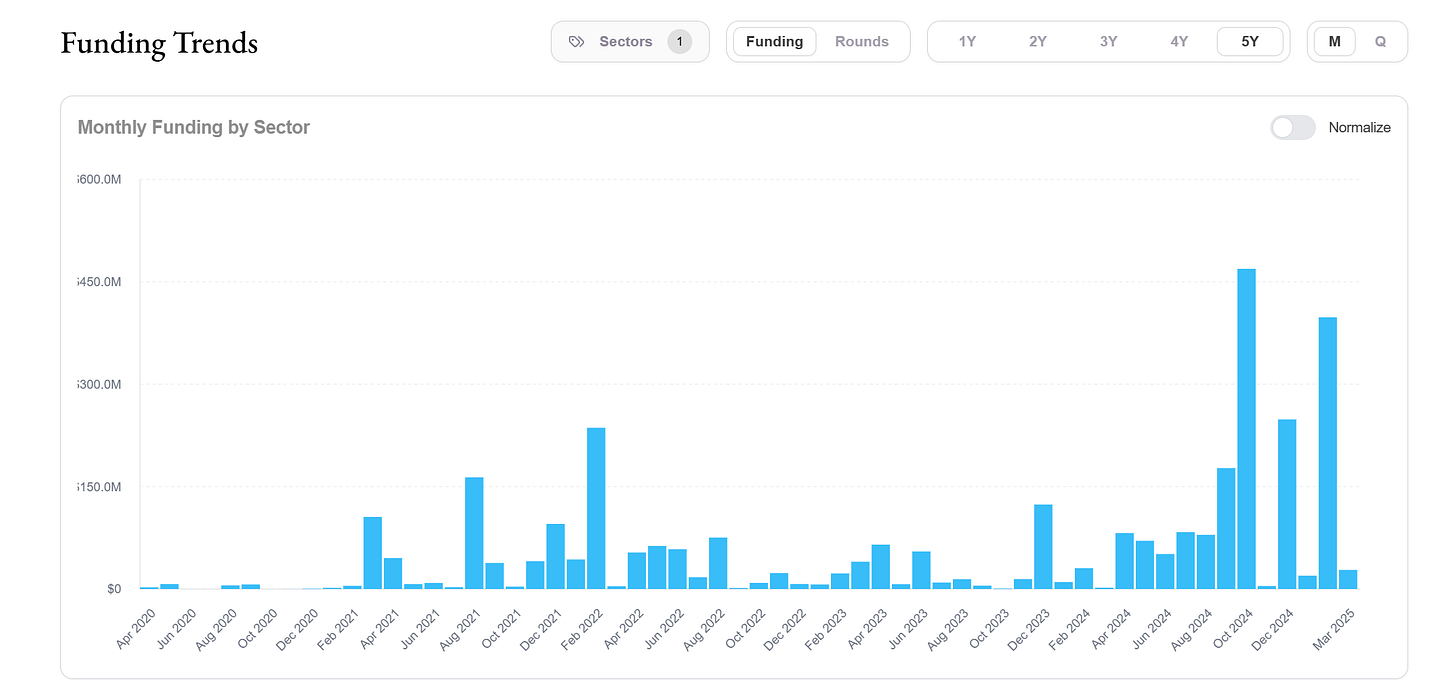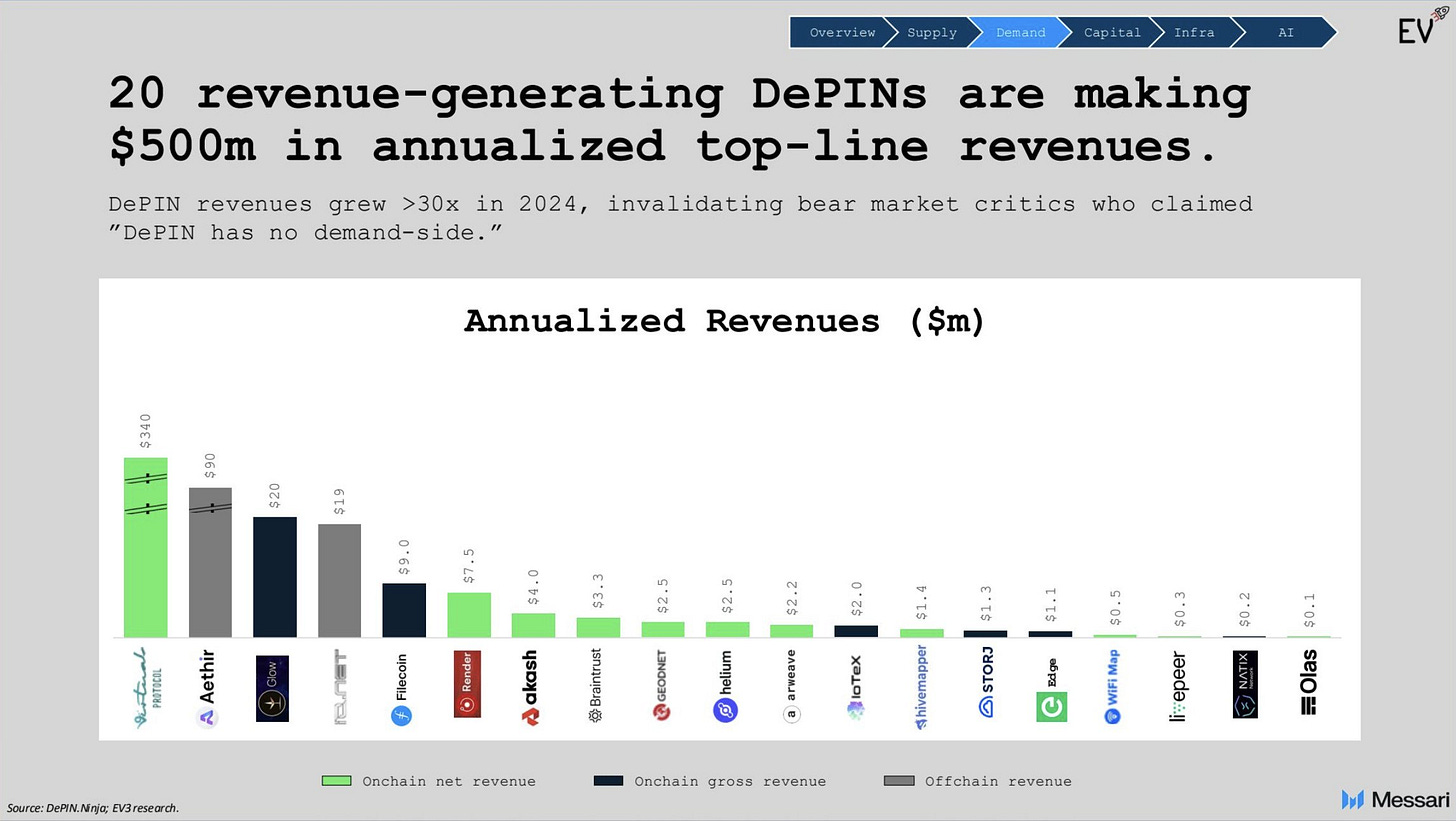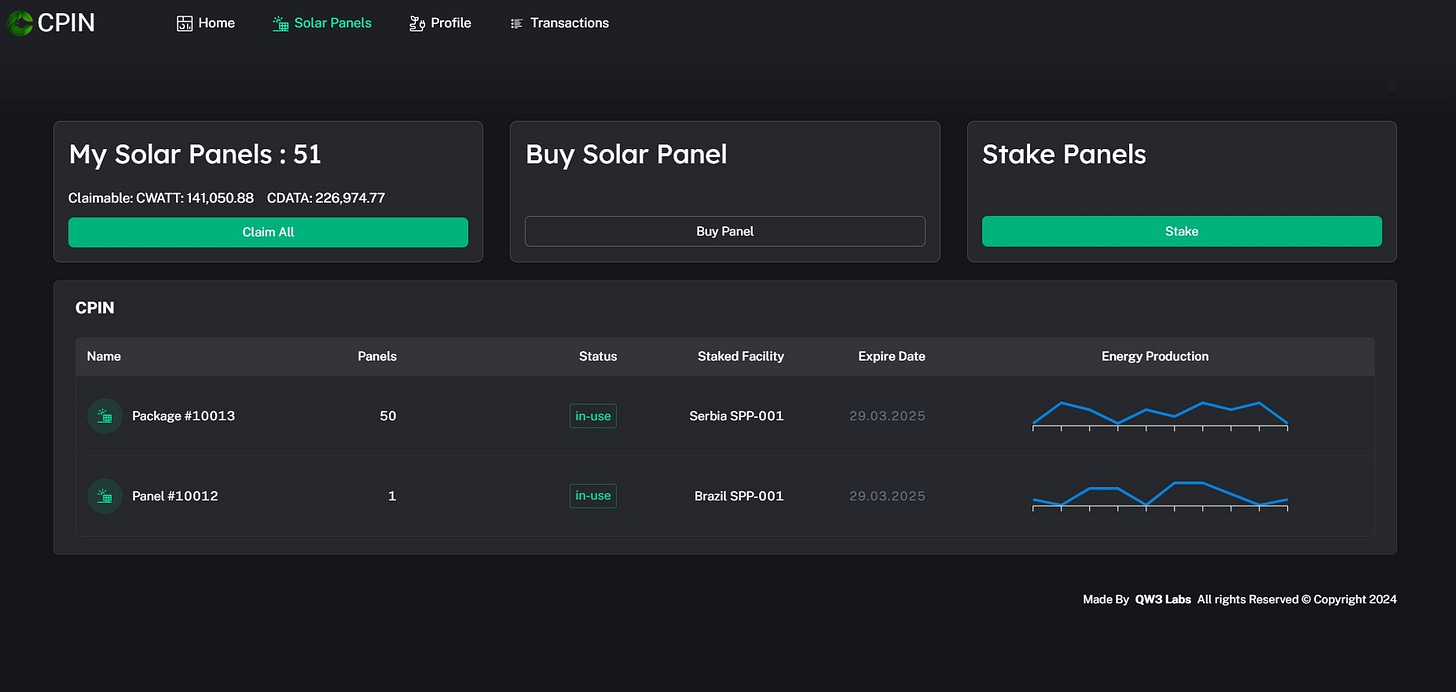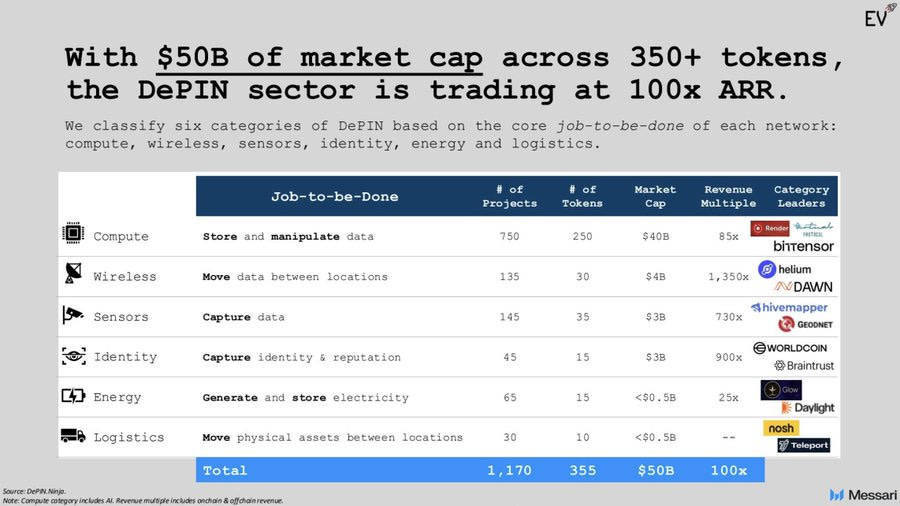Energy Capital Markets
Distributed Energy Resources, Virtual Power Plants, Carbon Markets & Beyond
Hello!!
The energy sector may not particularly be a very exciting one to explore, however, it is a pandora’s box for applications of new-world technologies. We know that power flows in only one direction – and I am not talking physics! Both literally and figuratively, power moves from centralized entities to passive consumers. Centralized refers to large entities, companies, or state monopolies that distribute electricity. Passive consumers are at the receiving end of this energy. They do not actively participate in the distribution of energy. So, it essentially works in a top-down manner.
The area of the energy sector, historically and to date, lacks innovation and of course, transparency. With recent developments and initiatives, however, the sector has started taking a new form. It is reshaping, turning businesses, houses, and communities into energy producers, traders, and beneficiaries. How - you may ask?
This has become recently possible with the help of Blockchain technology and crypto incentives. Decentralized Physical Infrastructure (DePIN) will further transform this sector to be decentralized and bring democratization.
In this article, we will explore how decentralization can transform the energy sector – in terms of trading and grid management. We will also map notable DePIN companies leading this transformational change. This is a bit lengthy, but hold tight! It’d be worth it by the end.
According to BloombergNEF (BNEF), we need at least $21.4 trillion to invest in the electricity grid by 2050 to support net-zero transformation. That does sound a lot but not impossible. In the year 2023, 10% of the global GDP growth rate was contributed towards clean energy initiatives. So, the goal may not be far-fetched but rather winnable with the help of decentralization.
Let’s take a step at a time and understand how energy sectors work.
How does the traditional energy sector work?
The world depends on infinite electricity. Undoubtedly, it is a crucial resource – we need it 24/7 365 days constantly to make things happen autonomously without any challenges. Electricity can be used for everything from creation to destruction in the world!
Unfortunately, electricity can neither be stored and provided later nor created at home using DIY equipment (at least not enough to fill the inherent dependency of humans on electricity). The instant electricity is produced, it is consumed, regardless of the distance between the producer and the end user. Electrical infrastructure is one of the greatest inventions of all time.
Electrical infrastructure is so widespread that most of our power grid is just outside in the open for anyone who wants to have a look. The electrical grid is one of the world’s largest machines.
So, how does the machine work?
The core function is to generate electricity and deliver it to those who need it. The image below shows a simple mechanism.
Naturally, electricity is produced from the generation side. All the wide variety of power plants have one thing in common: one kind of energy is converted into electrical energy.
Most power plants are situated away from populated areas so that electricity is efficiently transported and managed by high-voltage transmission lines. At the plant site, transformers boost the voltage to minimize losses within the lines as the electricity reaches the areas that need it.
On the transmission side, transformers reduce the power back to a safer and more practical voltage level. This process is done at a “substation”, which regulates the quality of the electricity and uses breakers to isolate potential falls in the equipment.
“Simply, substation transforms voltage from high to low, or the reverse according to the situations”
In some areas, energy customers receive power directly from transmission lines, but most are served through feeder lines that carry power from the substation. This process is called distribution — which involves small transformers stepping down the voltage further for industrial, commercial, or residential usage before the electricity reaches its final destination.
Instead of the constant flow of current in one direction called Direct Current (DC), the vast majority of the power grid uses alternating current (AC), where voltage and current change direction 60 times per second in North America (standard frequency is 60Hz) and 50 cycles per second in India (standard frequency is 50Hz), for reference. The key advantage is that with AC power it is easy to step up and down voltages — which is critical for efficiency and safety while transmitting electricity from producer to consumer. In this process, transformers play a very crucial role.
Think of the power grid as a marketplace, where power producers bring their electricity to the market by connecting to the grid, and consumers purchase it. The economics of the grid are more complicated, but the key aspect is that the power grid is a shared resource. That is why organizations oversee and establish rules on each participant in the production, transmission, and consumption of power may use it.
To maintain a power grid, there are three technical goals for engineers:
Quality - electrical devices are designed to assume that the power coming from the grid has certain parameters like voltage and frequency. Large power grids benefit from electrical inertia which is used to maintain stability of frequency.
Reliability - most of the challenges with the grid’s complexity come from how we manage faults and redundancy so that people rarely face blackouts rarely. The grid can re-route the electricity when a certain component of equipment is out of service.
Demand & Supply - electricity production and consumption happen on a real-time basis. Nobody calls the electricity board or utility company and informs us that we are going to turn on the AC or washing machine right? This means that not only does the generation have to adjust their production to match the extra load, but it also has to do it immediately without any warning/fallout. This microeconomics, indeed, becomes very crucial.
Electrical demand follows a fairly constant pattern, however, due to extreme weather conditions, it may create difficult to forecast sometimes.

Taking economics into consideration, typically, the cheapest sources of electricity are used to fulfill the more consistent base load. However, large power plants take hours sometimes days to startup and shut down. Equipment relies on maintenance and fuel costs vary. So there are problems!
Renewable energy sources like wind or solar can have unpredictable variations in capacity, resulting in irregular power to the grid. A simple example is the duck curve which exists in large-scale solar energy deployment.
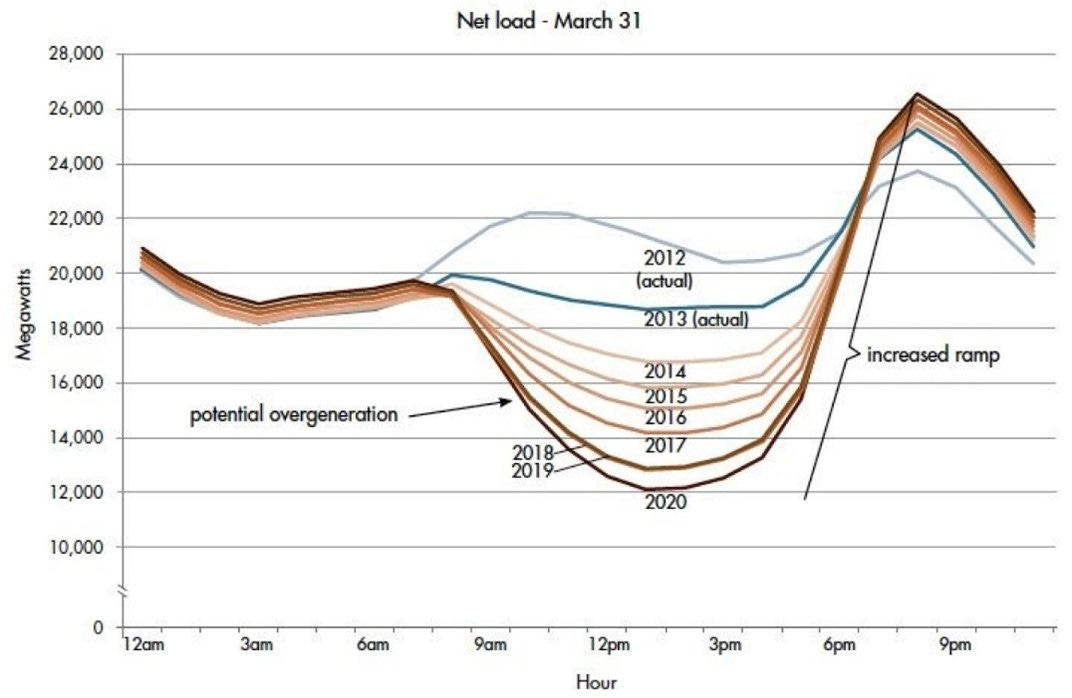
The duck curve represents the difference in electricity demand and the amount of solar energy available throughout the day.
You will see demand ramp up in the morning as everyone wakes up, which can be met. Then, overall demand dips down quite a bit during the day as solar and wind come into play. However, in the evening and night, as it gets cloudy and people return from work to home, simultaneously, demand ramps up again, making it challenging for the grid to meet the requirements – which creates a duck-like figure overtime on a 24-hour basis chart.
To tackle these problems, the energy sector started looking into making the grid ‘smarter’ by leveraging software and sensors to enable communication between devices.
On the supply side, it allowed us to digest huge amounts of data to help make decisions in managing the grid efficiently. This started two-way communications with the grid, unlike traditional architecture which enables one-way electricity delivery from central power plants to end customers.
On the demand side, smart grids enable consumers to make better decisions by showing electricity usage — making the shared resource effective and efficient.
To clarify: let’s say, you have smart appliances at home. On a hot summer day, when energy demand is at its peak as everyone is using ACs, your energy providers send a signal to your smart home through a smart grid. Your washing machine automatically adjusts and delays running its cycle until energy demand is lower, and in the case of a refrigerator, it operates in energy-saving mode.
Smart grids help in detecting and fixing power outages faster. It isolates the affected areas and reroutes power.
It provides an opportunity for utility companies to offer time-of-use rates. Users can manually adjust their usage, for example – running dishwashers or laundry at night.
Smart grids support renewable sources of energy like solar and wind.
It is efficient by reducing energy waste, lowering greenhouse emissions, and helping stabilize the energy process for everyone.
This sounds great, right? However, the smart grid has its challenges due to its centralization structure.
High Infrastructure Costs – The maintenance and expansion of centralized grids are very capital-intensive. Achieving a net-zero transformation will require at least $2.1T in grid investments by 2050. Most of these costs stem from the need for modernization of aging infrastructure.

Transmission and Distribution Losses - Centralized grids depend on high-voltage transmission lines to transport electricity over long distances which results in energy losses. The estimated energy loss is around 8% annually.
The logic is simple. The farther the electricity travels, the higher the losses, making centralized grids inefficient. Even with smart grids, although they monitor to minimize losses, the energy traveling longer miles is a fundamental challenge.
Vulnerability - Centralized systems are more susceptible to cascading failures. For example, a single fault in a transmission line or substation can trigger widespread outages, as seen in major blackouts globally.
Smart grids solve most of the challenges like natural disasters, cyclones, or equipment failures but introduce susceptibility to cyberattacks on connected devices and control systems.
Transparency - Consumers are passive users with minimal control over usage or pricing. With a centralized model, consumers’ choices are controlled and restricted compared to decentralized systems.
How Does Electricity Pricing Work?
Modern electricity market prices are determined by marginal pricing — the cost of the most expensive power plant needed to meet demand. Power plants bid to supply electricity and the highest-price plant that is needed sets the price for everyone.
Since renewable energy (like wind and solar) has zero fuel costs, it can offer lower prices when available.
Prices fluctuate due to factors like weather, fuel costs, and supply-demand changes. Extreme weather events like Texas’s Storm Uri in 2021 can cause prices to spike massively. This volatility makes it a risk for electricity suppliers, who sell power to consumers at fixed rates but must buy it from the market at uncertain prices.
To avoid financial losses, suppliers buy electricity in advance through hedging (locking in prices with contracts). However, if a supplier hedges too much or too little, they tend to lose money, as seen in the collapse of UK energy startup Bulb in 2021.
Electricity pricing is complex, driven by supply-demand auctions, and influenced by liberalization. New models like demand response (DR) allow suppliers to work together to lower costs and make energy systems more sustainable (more on this later).
These challenges highlight the importance of a paradigm shift in producing, distributing, and consuming electricity. These reasons market the need to decentralize, provide resilience, reduce capital costs, and improve pricing.
With these limitations of the traditional energy sector, it’s crucial to explore how emerging technologies like blockchain and crypto incentives are reshaping this landscape by fostering this landscape by fostering decentralization and innovation.
Distributed Energy Resources (DERs)
DERs are small-scale resources installed close to energy consumption sites which include a wide range of technologies like distributed Photovoltaics (PVs), energy storage, electric vehicles (EVs), charging points, batteries, and heat pumps. Therefore, depending on the type of technology, DERs can generate, store, and manage their consumption.
DERs can either be individual physical assets or aggregated virtually. Most often, DERs consume electricity generation, as the sources are smaller, more decentralized, and localized.
Typically, DERs can be found in private households, enterprises, or utilities. These are normally installed and located “behind the meter” — this is on the consumer side. DERs are intelligently integrated into wide energy systems and are controlled and monitored to improve the reliability and resilience of power systems. DERs can reduce transmission losses and low carbon emissions.
Physical DERs can be rooftop solar PV, fuel cells, small wind turbines, hydro and solar thermal. It ranges from 2kW to >5MW. If Small Modular Reactors (SMRs) gets commercialized at full scale, then it could potentially be added to this list.
DERs represent a foundational element of the evolving landscape. Building on this concept, Virtual Power Plants (VPPs) further demonstrate how integration and aggregation of DERs can offer enhanced grid resilience and efficiency.
According to Wood Machenzie’s 2023 US Distributed Energy Resources Outlook report, the US DER market is expected to double in capacity from 2022 to 2027, with $68 billion per year of capital.

In recent times, solar and wind energy have become significantly affordable and cost-competitive with fossil fuels. The nuclear is facing challenges with heavy-capital requirements and regulatory challenges. Natural gas (especially combined cycle) remains a key transitional energy source but faces increasing competition from renewables.
Virtual Power Plants (VPPs)
Virtual Power Plants are nothing but an aggregation of all DERs. If the megawatts of power are bundled and made available to electricity markets, it is called Virtual Power Plant (VPP).
VPPs can combine different types of physical assets, regardless of how they generate electricity, and function as one resource, just like conventional power plants. VPPs can ramp up and ramp down more quickly than centralized power plants. Plus, VPPs can do this virtually without limiting the geographical coverage of resources when grid conditions and relevant regulations allow.
By incorporating machine-learning algorithms, VPPs can digest large amounts of data, including weather forecasts, and real-time electricity prices, and optimize the operations of DERs.
VPPs do serve as a bridge between the consumers who own DERs and power systems and markets, providing a wide range of grid benefits.

Carbon Markets
Co2 emission goals were laid out by the Kyoto Protocol of 1997 and the Paris Agreement of 2015. Later, it was adopted by six countries, which gave rise to national emissions targets and regulations to support them.
Carbon credits, essentially allowances that permit the holder to emit a certain amount of carbon dioxide, play a pivotal role in regulatory efforts to control greenhouse gas emissions. Revenue from carbon credits flows vertically from companies to regulators, though companies may end up with excess credits — which are sold to other companies.
Whereas, carbon offsets flow horizontally, trading carbon revenue between companies. When one company removes a unit of carbon from the atmosphere, it can generate a carbon offset. This can be purchased by other companies — typically referred to as offset credits.
A simple example is Tesla, which generated $1.79 billion from carbon credits (reported in Q4’23 earnings and FY23 report). It has made around $9 billion since 2009. This revenue for Tesla had come from automakers who struggled to meet emission regulations in the US, Europe, and China.
Act Fast - in a better way!?
At its current state, the world is not on track to limit global temperature increases by 1.5 degrees Celsius. According to the UN, we are only 17% on track, which keeps us far behind in what we have to achieve given the limited period. Two major infrastructure challenges are delaying the progress:
The grids have become old and are designed for large, centralized fossil fuel plants.
Stronger incentives are needed to encourage consumers to deploy and install distributed energy resources (DERs) like solar panels.
The industry needs to invest $21 trillion in clean energy transition over the next 25 years.
DePIN can solve these infrastructure challenges using token incentives and blockchain as a coordination layer in crypto-economics. This concept can accelerate the deployment of more DERs in the market.
Basic Questions: What are DePINs?
Decentralized Physical Infrastructure Networks or DePIN, represent a new way of building and scaling real-world infrastructure. These networks rely on token incentives to align economic interests and encourage individuals or entities to contribute capital, resources, and labor.
DePIN accelerates the development of decentralized infrastructure by tapping into crypto-native capital formation and incentivizing resource allocation.
Like every network, DePIN functions with two critical components: Supply and Demand.
Supply Side - Token-Driven Incentives
DePIN projects use tokens to build necessary resources like capital and equipment to grow the infrastructure at a global scale. DePINs excel at scaling supply efficiently, but their long-term sustainability depends on how effectively tokens are allocated. The tokenomics play a crucial role in shaping any DePIN project, maintaining scalability and capital efficiency.
A few models which are being used to distribute tokens:
Time-based: some projects reduce token emissions by halving every two years, ensuring a gradual supply adjustment.
KPI-based: some projects tie tokens to performance metrics, like the percentage of global roads mapped or deployment of certain megawatt power and, enhance with city-specific and time-based multipliers.
Demand-based: token emissions adjust based on how actively the network is used by consumers.
Tokens are a crucial aspect of any DePIN ecosystem, as they act as both incentives and functional units. As tokens are finite in most cases, managing emissions efficiently is critical.
Few projects in this ecosystem have been experimenting with alternatives like “Points” systems instead of directly issuing tokens.

Demand Side – Real-World Utility
The demand side depends on real-world utility. The demand is largely independent of market cycles and is a key driver of sustainable revenue streams, to accrue value back to the tokens.
Typically demand can be categorized into:
Business-to-Business (B2B) - If the network’s output like data or service is consumed by enterprise clients, these clients typically pay in fiat, generating off-chain revenue. In these cases, mechanisms like token buybacks or burns are often used to translate this revenue into on-chain activity, thereby linking enterprise usage to the network’s native token economy.
Business-to-Consumer (B2C): The network serves individual consumers who directly utilize the network’s services or data. This is a direct on-chain activity, as consumer interactions often involve token transactions.
Many DePIN projects use models like Burn and Mint Equilibrium (BME) to balance revenue generation and token distribution while maintaining stability.
Here is how it works for a decentralized energy grid:
Customer Payments – Consumers like households or businesses, pay for electricity usage via fiat or stablecoins. These payments are converted into the network’s native tokens in the backend.
Producer Rewards – Energy producers, like solar panel owners or wind farm operators, contribute to the grid supplying electricity. These entities earn points based on the amount of energy supplied and the time of contribution (ex-peak demand periods earn high points).
Token Distribution – At the end of a specific epoch (week/month), these points are redeemed for native tokens minted according to a predefined inflation schedule.
Burning Mechanism – Tokens used in consumer transactions are burned, reducing the circulating supply and typing token value directly to energy demand.
Additionally, revenue generated from off-chain customers could be used for token buybacks or reinvestment in the grid’s infrastructure. This ensures a continuous cycle where increasing demand for energy translates into on-chain activity, balancing incentives with revenue generation.
$3.8 trillion is the projected market size of the global DePIN by 2028. Right now, the total DePIN stands ~$20 billion. With a huge market size, DePIN is still in early-stages, and just imagine how early is it to the DePIN-Energy sector.
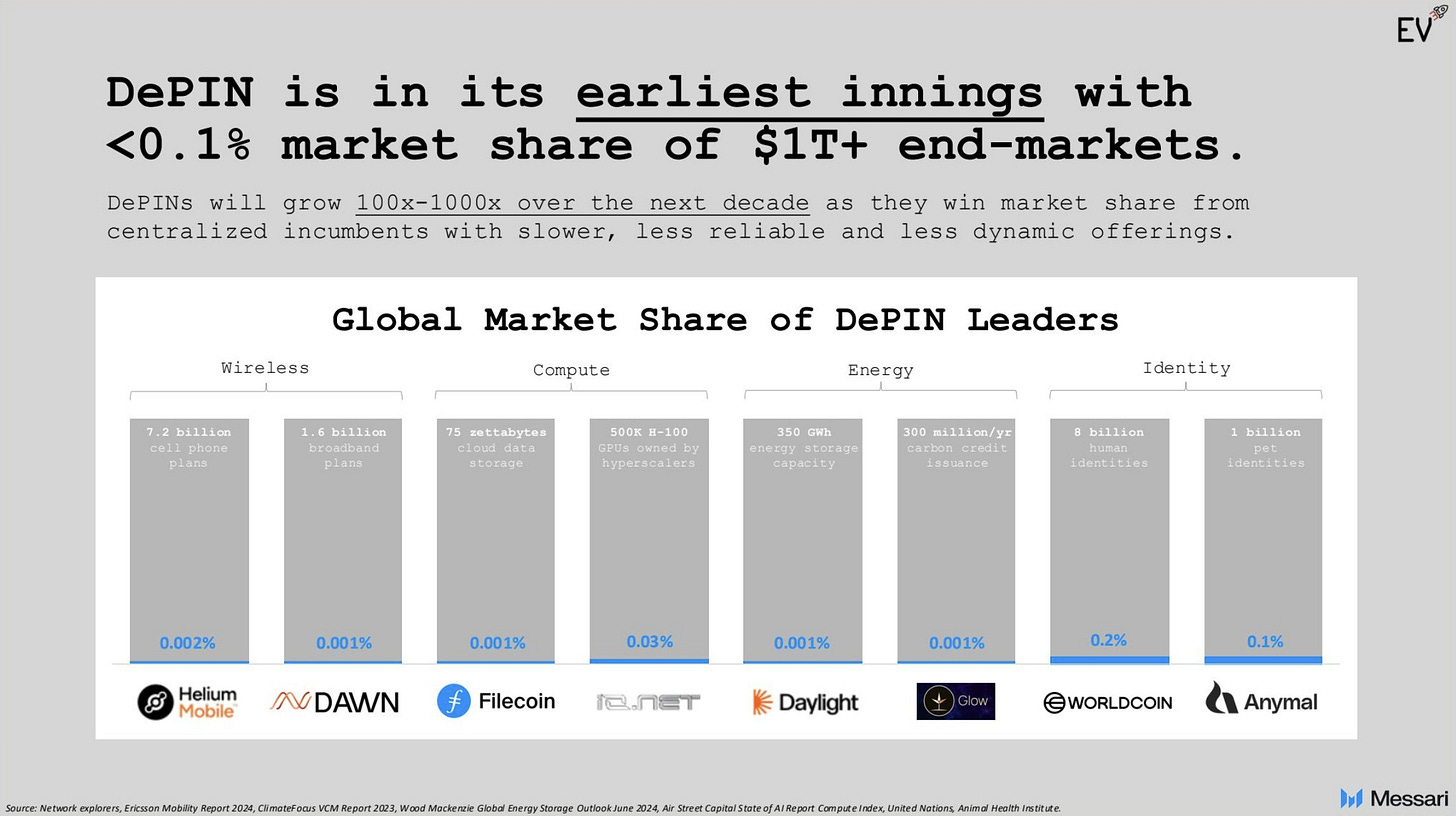
The rapid growth of DePIN in the energy sector can be attributed to its potential to address specific challenges such as grid inefficiency, high carbon emissions, distributed energy production, and the need for more resilient energy systems. The crypto ecosystem holds more than 80 projects to solve the challenges in this sector.
Typically, there are four use cases where we will find DePIN projects positioned:
Peer-to-Peer (P2P) Energy Trading
Generation
Transmission & Distribution
Demand-Side Management
Let’s explore some of the projects, I felt interested in this sector. This is not a deepdive on any project but just an exploration and understanding of their offerings in this sector. I have nearly touched on more than 45 projects in this article.
Generation
This sub-sector includes projects that support generating energy either by financing or certifying renewable energy assets and allowing for trade.
Some projects are focused on enabling financing for renewable energy projects like solar farms through tokenized models — allowing for broader participation.
Asset Financing - Tokenizing Renewable Assets
Nova Real Chain (Rebranded - Hydro The RWA DePIN Protocol)
It is focused on tokenizing real-world assets (RWA-DePIN). The project is involved in tokenizing various physical assets across sectors like real estate, art, commodities, agriculture/lands, IP, infrastructure, private equity, and energy sector. The platform provides a marketplace for tokenized assets and a dashboard to manage assets.
In February 2024, they rebranded themselves as RWA DePIN Protocol to reinforce their value proposition — by offering innovative infrastructure that enhances the tokenization and democratization of real-world assets in a decentralized and secure approach.
To maximize its offerings, it combines Ethereum’s liquidity with the power and low fees of the SUI blockchain. It offers investment opportunities starting from $100.
The project has its own token - $DEPIN — which offers users exclusive benefits while contributing to the ecosystem. $DEPIN token is deflationary-based, having a combination of token buybacks and burns — reducing supply, creating scarcity, and supporting long-term growth.
As more users join the $DEPIN network, demand increases for the $DEPIN token through the utility and significance of its platform. $DEPIN users gain loyalty-based programs gaining higher yields through staking, reduced fees, and exclusive privilege in asset trading.
Coming to the protocol, its offerings are very comprehensive. There is an RWA marketplace for buying and selling tokenized real-world assets, with fractional ownership options. Then comes RWA Launchpad, which connects investors with carefully vetted projects. RWA Launchpool is a fund pooling mechanism where users’ funds go into tokenizing real-world assets — thereby offering returns to users aka investors. RWA Masternodes act as the backbone of the ecosystem, by powering tokenization and network operations.
The protocol launched a project — MINEBTC. It is a tokenized BTC mining land that is backed by a hydro-powered Bitcoin mining farm. It owns digital land and earns Bitcoin passively. It conducted its first launchpad sale for the $MINEBTC token — where it achieved a 320x return for IDO participants on day one of its launch. However, it has lost 6x of its market cap since its launch. It currently has a $920k market cap.
In 2025, their focus is on launching and expanding the $DEPIN ecosystem. The H1’25 includes the Token Generation Event (TGE), node sales, an affiliate program, a launchpad of projects, staking rewards, and a marketplace for tokenized assets. In H2’25, the protocol plans to introduce equity tokenization, secure regulatory approvals, build institutional partnerships, and optimize according to user feedback.
I personally will look forward on the launchpad projects the protocol is focusing on — solving a large-scale real-world problem.
Plural Finance works with renewable energy developers (mostly solar) who are looking for capital funding to connect them with individuals discovering renewable energy projects to invest in. It states that it lists projects that have good historical performance and rejects those that are bad.
Plural is SEC-compliant — registered transfer agent and works directly with SEC-registered broker-dealers, KYC providers, Anti-Money Laundering Technology, and more for investor confidence.
It currently offers a Deal-by-Deal service. However, they are looking forward to launching Fund Token and Secondary Marketplace to expand and have ease in the accessibility of its offerings.
Recent Project - Plural Finance tokenized the Opdyke Microgrid Deal, making institutional quality clean energy investment accessible to investors. Blockchain has reduced administrative costs, automated compliance processes, and enhanced transparency. The protocol structured the deal traditionally with stable cash flow, priority returns, and clear exit options.
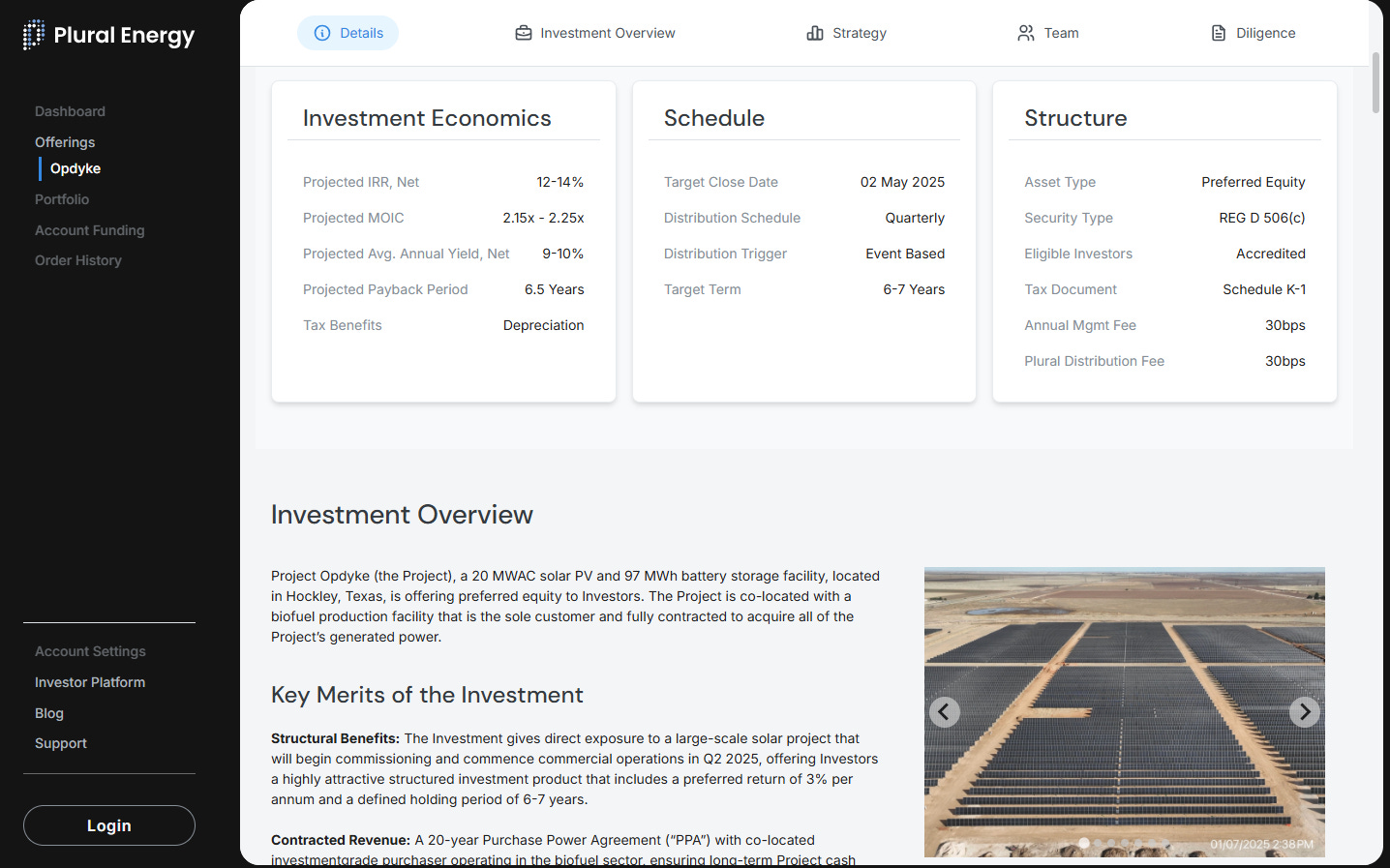
The Opdyke Microgrid Deal offers investors mid-teen returns (12-14% IRR) through a 20MWAC solar and 97MWh battery storage project in Texas, powering a biofuels facility via microgrid.
Lately, the team had announced their acquisition of Northstar Financial Services LP, a FINRA-registered broker deal — renamed as Plural Brokerage LLC. By owning a broker-deal, Plural can facilitate securities transactions in-house — making their security token offerings more compliant and faster.
Plural aims to tokenize over $100 million in assets in 2025, making it easier for institutional and retail investors to fund clean projects. This project is built on the Ethereum blockchain, and the team has raised $2.33 million in pre-seed funding.
Plural stands right in the middle of financing energy assets, positioning itself by enabling mid-size renewable energy projects to raise funds from investors on-chain. Plural looks at small-scale projects (like rooftop solar installations), development-stage renewables, operating renewables (which need additional fundraising), and unconventional clean energy projects like AI-powered batteries and Bitcoin mining operations integrated with renewable energy.
I think its value proposition is on point. It makes it less attractive for large-scale energy investors but exciting for individual/retail or institutional investors (small-to-mid-size). Apart from solar, the team is also looking into renewable energy sources like wind and hydropower — an untapped opportunity.
Penomo is similar to other projects, focused on tokenizing solar farms, wind farms, and storage batteries. Penomo partnered with regulated entities, ensuring adherence to BaFIN (Germany) and EU securities regulations — enabling tokens to be legally distributed to retail investors in the EU and institutional investors worldwide.
It digitizes the onboarding process and assesses the financial viability of each project through cash flow modeling. It provides real-time monitoring of tokenized assets, enabling transparency and returns on the performance of the invested projects. Its total asset value is more than $200 million — which is just scratching the surface!
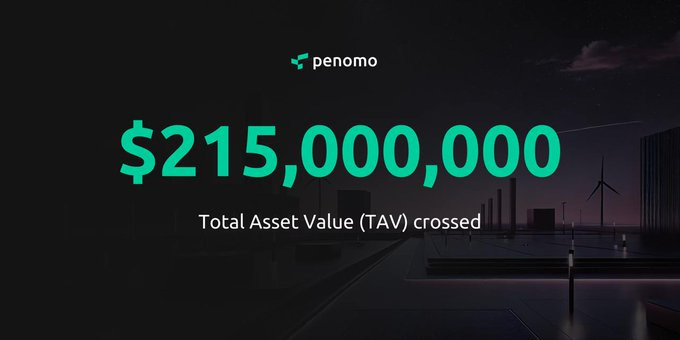
Penomo has partnered with Hoovest Financial Group, which manages over $1 billion in assets, to accelerate institutional investment in tokenized real-world infrastructure — especially focused on renewable energy and AI-driven projects like data centers.
Hoovest, with its expertise in capital allocation and $150 million AUM, will deploy capital through Penomo’s platform — bridging the gap.
The project has a token launch — $PNMO, which is a utility token that can be used in transacting on the Penomo platform and for the governance of the project. $PNMO does have a buyback scheme — repurchasing tokens from the market (from the revenue via service fees, transaction fees, and liquidity trading fees from trades) to create constant demand for the token. Then, these tokens are distributed to their contributors via pools. It does this in three ways: (1) a burn pool where tokens get burned/removed permanently, (2) rewards pools where tokens are distributed to compliance service providers, ecosystem builders, and users, and (3) a subsidy pool where tokens are reserved to subsidize impact-driven projects. Check out more on their tokenomics structure here.
Lumishare offers users an NFT marketplace with $LUMI tokens, allowing users to invest in solar farms through fractional ownership services. Built on Binance Smart Chain (BSC), this project extends its offerings by partnering with governments like the UAE to capitalize on opportunities.
$LUMI Token is used for all transactions on LUMIPlace (a marketplace). NFTs which represent ownership of physical assets can be purchased and traded on the marketplace. The smart contract framework also integrates reward mechanisms, like staking rewards or dividends from the performance of solar farm projects.
$LUMI is currently listed on Mexc and Latoken (CEXs) and is looking to expand to other large centralized and decentralized exchanges. Its market cap stands at $1.36 million.
They recently made their LumiPlace public which is in the testing phase.
Other protocols certify renewable energy production and tokenize it into tradable assets like carbon credits or Renewable Energy Certificates (RECs).
Certification and Trading
Glow is a platform that decentralizes the grid by rewarding solar farm developers with its GLW tokens for their electricity production and USDC for their carbon credits.
It has a Partner program, which encourages corporations to buy Glow Carbon Credits.
Glow rewards builders with USDC and GLW tokens when they construct new solar farms that compete with traditional energy sources. It uses an incentive mechanism called a ‘recursive subsidy’, which requires owners of solar farms to contribute 100% of their electricity savings and revenue towards the construction of more solar projects, creating an amplification effect.
The project embraces this mechanism because the carbon industry lacks an effective incentive mechanism between profitable solar farms and solar farms that need financing. This mechanism enables profitable solar farms to invest in them and receive carbon credits (Glow Carbon Credits), which represent one ton of CO2 (that has not been emitted into the atmosphere due to GCC).
Rewards from a finite pool get distributed between all competing solar farms proportional to the number of carbon credits or GCC tokens they hold.
It’s almost a year since Glow began operating, and the project has already received major traction from countries like the U.S. Recently, it raised $30M from Framework and Union Square Ventures. The team states $6.5M of funding goes for the project and the rest, $23.5M, would be towards solar investment.
Glow has 71 operational farms, producing 6.8 GWh of electricity. Glow launched three solar farms in Rajasthan (India), generating 21.3MW of capacity.
The most generated solar farm is in Rajasthan with a deployment of 29k solar panels generating 22% of GLW emissions.
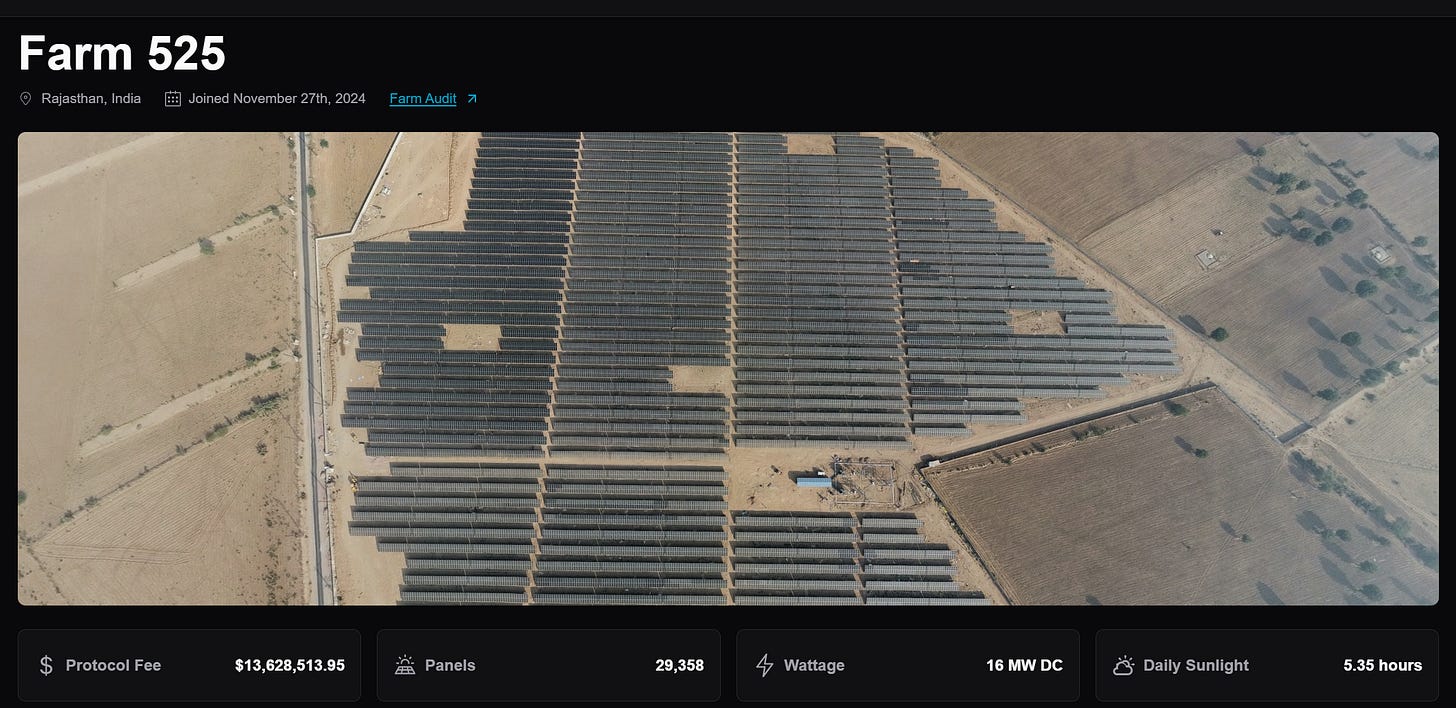
Glow is one of the dominant energy DePIN projects in terms of operations and revenue generation.
This project is poised to become one of the largest (although 6.8GWh is still relatively small) in decentralizing the grid infrastructure, enabling energy trading accessible to large participants
It focuses on managing Renewable Energy Certifications (RECs) to ensure that energy production is verifiable and tradable. Initially powered by the Polygon blockchain, but the project recently migrated to Base.
For generators, it facilitates the sale of Energy Attribute Credits (EAC), while Climate Actors redeem EACs to attribute scope-2 emissions. It serves as a two-way bridge between these participants by enabling a marketplace.
Generators can tokenize EACs to claim Energy Attribute Tokens (EAT), which can be used to receive Jasmine Liquidity Tokens (JLT) and convert them to USDC. On the other hand, Climate Actors can buy and burn JLT in Jasmine Reference Pool, to receive EAT for energy use.
Solareum is an EVM layer 1 blockchain powered by renewable energy sources. It operates on two types of mechanisms: (1) Proof of Generation (PoG) and (2) Proof of Holding (PoH).
It tokenizes renewable energy production through the PoG mechanism, where users can convert their energy into digital certificates or tokens. The tokenized energy can be used for energy trading in the P2P market. With the PoH mechanism, users can participate in the governance of the Solareum platform.
Recently, the protocol announced its progress toward mainnet launch, airdrop campaign, and scalability enhancements. It had completed a dual-token model for Tesla Powerwall and Lion Energy API.
The project is looking for mainnet launch and V2 updates in 2025, where they are going to announce the roadmap, launch plans, and future developments of Solareum.
It started to solve market failures in the carbon market by deploying its platform on the Polygon blockchain. In 2022, KlimaDAO launched its carbon retirement aggregator, enabling individuals and organizations to offer their carbon footprints.
The ecosystem benefits carbon brokers, traders, and consumers by providing a neutral liquidity layer for the carbon market. The goal is to initiate projects like providing public goods, helping them to reduce carbon emissions, and improving living conditions.
The project currently has 20.3 million carbon credits on the platform – equivalent to the annual emissions of a small country or Indian states like Goa and Himachal Pradesh.
In a similar space of on-chain carbon retirement and carbon offsets, there are projects like Toucan, C3, and Moss, Carbify and, Virdis, which offer users the opportunity to offset their carbon emissions. Some of the projects that are not listed on the map are Dovu Labs, Sun Contract, REGEN Network, Menthol, and Kwota. All these projects provide a marketplace for carbon credits.
Transmission and Distribution
In this category, we’ll explore projects that facilitate the logistics of energy across the grid by managing distributed systems and enhancing the efficiency of the grid.
Virtual Power Plants
Clean Infrastructure Network (CPIN)
CPIN’s mission is to build a decentralized Virtual Power Plant (VPP) through solar panels and other renewable energy sources.
7 solar power arrays have been live on the network since launch, and are plans to have 20 facilities and 1000+ solar panels.
The idea of CPIN is to operate via $CWATT and $CDATA tokens, which are to be deployed on Peaq (a layer 1 DePIN blockchain), enabling users to buy NFTs representing fractional ownership with $ Peaq tokens through its application.
CPIN leverages peaq’s modular DePIN functions like peaq ID and enterprise network to mint tokens and solar panel NFTs.
CPIN is yet to complete its phase 1 development, which includes CPIN token launch, private sale, and CEX listing. Then it looks to transit to phase 2 development, where it would launch its platform, panel sales, and offer launch explorer.
Peaq is known for being a DePIN blockchain, and I look forward to what CPIN has on the table to revolutionize the energy sector via crypto.
Sourceful is a Solana-based protocol that allows homeowners to engage in energy transition and receive rewards for their contributions. It allows individuals to take control of their DERs (solar panels or small-scale systems) by providing hardware, that they can connect to VPP, aggregating their energy contributions to the grid.
I think the business model is interesting as it aims not to rely on charging high margins for hardware solutions or installations for its products — Gateway and Dual Miner.

A Solana blockchain-based platform focused on building a large, decentralized network by creating a VPP with 1 terawatt (TW) of combined physical and virtual renewable energy capacity. The project is backed by Multicoin. The business model is similar to Sourceful, where it sells hardware solutions and allows these systems to connect to VPP. It aims to manage and reduce energy consumption using smart technology for better control.
The project has partnered with Fuse Energy to provide services for energy upgrades like solar panels, batteries, and EV chargers. The project is building an EV charging platform that makes it easy for EV owners to locate, pay, and earn rewards for charging their vehicles.
Participants can earn ProjectZero tokens by contributing to the network using installed DERs. These tokens can be redeemed for discounts on solar installations and energy-efficient devices.
It implements supplier-user coordination or demand response model where suppliers can adjust their electricity buying strategy based on real-time market conditions. Customers shift their energy use to reduce costs and balance the grid to make electricity cheaper for both suppliers and customers.
The project is focused on addressing the challenges of intermittent renewable energy sources and creating a smarter and resilient grid. It looks to integrate solar panels, batteries, and smart home appliances to leverage data connectivity, aggregation, and advanced energy management. The protocol is a specialized EVM built on the Ethereum EVM, which executes Reactive Smart Contracts (RSCs).
It’s a decentralized energy network that connects users and providers, optimizing energy distribution and enabling p2p transactions.
Starpower addresses the given challenges by building a VPP, which is integrated into DERs like ACs, EVs, and factory equipment into a unified network. It aims to build a ‘communication layer’ that functions like the TCP/IP protocol of the internet but is incorporated with token incentives to capture economic value at the protocol level.
It bridges the gap between energy devices and VPPs using software and hardware solutions that can be connected to home appliances.
On the hardware side, it offers smart plugs, thermostats, home storage batteries, and EV chargers. On the software side, it is focused on connecting devices from various manufacturers so that users can manage them through their platform.
The protocol is deployed on the Solana blockchain, with 50k+ device users and more than 5000 daily active users (DAU) across 781 cities. Currently, the project is into three hardware solutions: (1) Starplug which costs $109, (2) Starbattery, and (3) Starcharger (a DePIN-powered EV charger).
It has partnered with Jiangsu Weiheng Intelligent Technology Co. Ltd to develop smart energy storage technology. Interestingly, its focus remains on innovative chemistries like solid-state batteries, lithium-silicon anodes, and advanced electrolyte formulations.
Solid-state batteries are high-density battery technology, that improves safety by eliminating liquid electrolytes, which are the root cause of thermal runaway. However, solid-state batteries have challenges in development and production as they lack ease of integration into the existing production process. Glassy sulfides and polymers are less disruptive compared to ceramics, which require new manufacturing processes.
The protocol has a token $STAR 0.00%↑to incentivize its users to participate in the network and applies a burning mechanism (burns its tokens via revenue) to maintain the high value of its token. Its incentive mechanism transitions from Proof of Connectivity (PoCn) to Proof of Response (PoR). This transition happens in three stages via data collection and verification.
At PoCn, Starpower validates the number of devices connected to the network. Then Proof of Capacity (PoC), encourages users to submit the energy capacity of their storage devices, generation unit, or consumption data. Lastly, with PoR, users provide energy supply or demand within a specified timeframe when a VPP signal is issued.
The project is currently testing its cutting-edge Battery Energy Storage System (BESS) for the data center, delivering milli-level energy response of uninterrupted power for AI applications.
I am highly bullish on this protocol given its focus on three hardware solutions, and its partnerships in implementing innovative battery chemistries. Although the project stands at the hardware stage, I look forward to future developments through software integration and ecosystem building.
Combinder lets users connect energy devices (DERs) to its network (VPP) by incentivizing them with $BIND tokens for providing data and flexibility to their VPP. The protocol is natively built on the Peaq blockchain. The team had raised $500,000 in Pre-Seed funding, giving it a valuation of $10 million.
The protocol is currently under limited beta (with 3000 participants) and secured 9 business partnerships in smart hardware, VPP, and carbon finance. It is looking to launch its marketplace and token in 2025.
It connects DERs into a unified network, which integrates and monetizes the data from these systems. It creates a seamless network for data collection, validation, and monetization. The network operates on four distinct types of tokens rewarding users and providing ownership to its participants in the ecosystem.
The team leverages Soul-Bound Token (SBT), which serves as a unique decentralized identity for global users to participate in the network. This is a dynamic NFT, which is upgraded according to the contributions to the network.
GPN is the protocol and governance token of GreenPower Network. This token is rewarded to participants who maintain the network and is used for internal transactions on the network. GPU is a reward token, distributed to users after participating in real economic transactions. Whereas, GPT is an NFT-Fi token, designed for NFT rewards and consumption.
DEG offers energy-related services like storage, optimization, and p2p energy trading without requiring users to own infrastructure. Businesses and consumers can access battery storage solutions, reducing dependency on volatile grid pricing.
DEG enables fractional ownership of energy assets, to allow stakeholders to earn revenues from surplus generation. Apart from this, it allows energy producers to sell carbon credits through their marketplace.
It has its token $DET which facilitates transactions and cross-border settlements. DEI collaborated with the Unified Energy Interface (UEI) for seamless EV charging demand response and grid services. Governments and regulators can use DEG for carbon tracking, policy compliance, and grid modernization.
The team plans for AI and data-driven optimization, where AI-powered demand-response models dynamically allocate energy storage and pricing to prevent volatility. Check out more about the project here.
It lets users power their houses with renewable energy and helps in earn rewards by contributing to the grid. It offers the chance to upgrade their homes with solar panels, EV chargers, and heat pumps.
Acting as a facilitator between participants and installers who handle end-to-end services, from design to installation. There is a potential direction opportunity for Daylight to become a VPP in the future.
It is operated through a Proof-of-Flexibility (PoF) mechanism that rewards smart energy devices with $GRID for committing to providing flexible energy capacity to the grid in the future,
Demand Side Management
Protocols in this category focus on consumer-facing components, like energy consumption, optimization, and management.
Energy Management Systems
Rowan Energy is a custom blockchain-based platform designed to reward people for generating green energy from solar panels. It creates a p2p system, where energy producers can earn rewards (tokens) and certificates for energy generation.
Rowan Rewards pays solar panel owners £0.10 per kWh, reducing their payback period from 15 to under 10 years. Solar installers get a new product to offer, helping them stay competitive, while distributors benefit from increased demand for SmartMiner devices.
With the data, Rowan creates high-quality carbon offset certificates and builds an energy trading network.
Smart metering – SmartMiner which confirms whether energy is renewable or not. It offers two different certifications to its participants:
Rowan Offset Certificate (ROC) represents carbon credits where businesses or individuals can reduce their carbon emissions.
Renewable Energy Certificate, issued to trade renewable energy p2p.
By March 2025, it has onboarded more than 70 distributors, upgraded SmartMiner before mass production, and announced solar and biomethane deals which are in the works.
Arkreen serves as a bridge between DERs and the global marketplace for carbon offsetting. Arkreen operates through a closed-loop ecosystem to balance both supply and demand. It focuses on the integration of batteries and smart meters for energy management.
On the supply side, Arkreen captures data taken from households and quantity their environmental behaviors through Proof of Physical Work (PoPW). On the demand side, it facilitates the creation of a tokenized marketplace for green assets (ART).
$AKRE token is a utility token for on-chain energy assets. The project generated 20M+ $ARKE tokens via protocol services.
In phase 1, Arkeen achieved more than 200,000 global solar energy nodes, and issued 120M kWh tokenized RECs with 1M+ transactions on-chain. It has built a P2P marketplace for retail REC trading.
It has five key offerings to potential users.
Community Solar Program (CSP) - which acts as a green energy node monetizing existing Solar PV plants up to 40kW.
Power Generation Program (PGP) - a smart switch, where users can earn rewards and offset their appliances’ daily electricity consumption.
Remote Miner and Pro - which lets users earn rewards from equivalent 100W renewable energy generation equipment without setting up their own. With the pro version, it expands to 500W which is generated by PV plants that are REC-registered.
REC RWA (Limited) - Arkreen issues ART against 1000W energy generation.
The protocol looks to connect 1M DERs globally in the next 2-3 years and adopt 100 web3-based companies. It also looks to develop DeFi models for energy assets, on-chain futures, leasing, and lending in 2025.
M3tering’s focus is to help buildings, and businesses reduce costs through consumption tracking. It is a hardware as a service provider, aimed to drive capital investments in DERs with rooftop solar projects, especially in Latin America and sub-Saharan Africa, by rewarding individuals and institutions to become electricity providers through rooftop solar purchase power agreements (PPAs).
The protocol is deployed on the Gnosis chain.
M3ter device is a crucial offering that enables electricity providers (who have invested infrastructure either in solar panels, batteries, or inverters to generate/store electricity). It needs servicing on a regular basis to maintain optimal performance.
M3tering leverages Switch Electric’s hardware and brings software solutions along with its $SLX token.

Installing M3ters enables individuals to measure the electricity generated and consumed. Providers can participate in the M3tering protocol to sell their clean energy for pre-paid stablecoins and earn rewards. On the demand side, the energy receiver pre-pays for the energy on kWh-basis in xDAI (a stablecoin issued by MakerDAO).
The company is focused on decarbonizing the global economy. It offers a mix of software services, licenses, and government contracts. Energy Web operates as a Blockchain-as-a-Service (BaaS) provider for the energy sector. it is powered by Polkadot Relay Chain. It uses Proof-of-Authority (PoA) consensus to balance decentralization and performance. Validator nodes are operated by reputable energy market participants for the reliability and security of the network.
The platform includes the Energy Web Decentralized Operating System (EW-DOS), which provides a framework for developing decentralized applications in the energy sector. EW-DOS is built on a three-layer architecture to meet operational and regulatory requirements.
It offers Green Proofs, a software solution that enables companies to demonstrate sustainability through verifiable data. It supports buying and selling low-carbon services and commodities, launching green product registries.
Apart from this, it offers a data management solution to handle DERs, and Universal Energy ID for decentralized identity — which can be leveraged to support interoperability functionality.
In 2023, it launched a framework - Green Proofs for Bitcoin (GP4BTC) to help companies reduce emissions associated with crypto mining.
It has its token $EWT to support transactions and asset management. The market cap stands at around $56 million with active daily users of around 50 and 544 weekly. The project is one of the fastest growing projects on Polkadot and the project had received new EU projects, expanding its offerings to aviation and maritime sectors.
Storage Solutions
Energy Cube aims to decentralize energy solutions via DERs to collect data from all discharging devices. In phase 1, it is focused on Home Energy Storage systems such as batteries or inverters. To reduce reliance on government subsidies, it has developed a decentralized incentive model encouraging users to maximize electricity utilization through self-consumption and participation in demand response (DR) activities.
Users are allowed to tokenize and trade surplus energy which reduces the costs and complexity associated with energy trading and distribution methods. The interesting part is unlocking the value of renewable energy assets by transforming energy storage systems into ‘super nodes’. These nodes can generate new revenue streams for users by turning surplus energy into valuable assets.
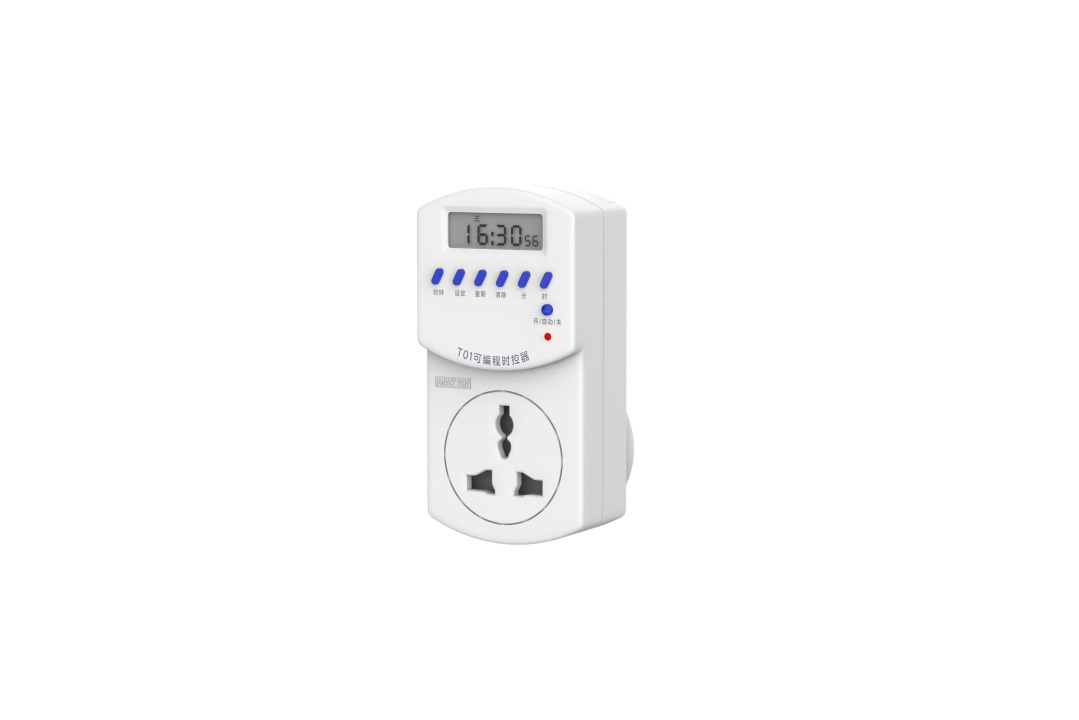
It has a $ECT token which facilitates protocol interactions. According to the team, they were set to launch the token in Q2’24, however, I do not see any information regarding the token in the public domain and Peaq’s explorer.
Similar to Energy Cube, Entheos offers tokenized batteries or storage-as-a-service to its users to drive local energy independence. It is built on the concept of batteries, which are software embedded that can store and release energy.
Through its RebelCore Controller, which is an advanced battery management system — extends battery life, improves efficiency, and reduces costs making energy storage more viable. It has created a new asset class to attract global investors interested in energy storage management.
It offers simple solutions for the unpredictability of renewable energy sources like duck-curve scenarios in solar energy generation. The project partners with Plural Energy, which facilitates tokenizing assets for small and mid-sized investments.
Charging Solutions
These protocols are primarily focused on EV charging, offering charging-related products in optimizing, providing charging networks, and managing energy consumption.
Protocols like DeCharge, and QoWatt, offer charging station solutions to its customers. DeCharge’s 7kW modular charging systems let anyone own, host, and earn rewards from charging infrastructure. The other protocols include EVDC, C+Charge, Charge.xyz, and PowerPod which offers similar products and services.
Peer-to-Peer (P2P) Energy Trading
In this category, protocols enable direct energy transactions without intermediaries, fostering decentralized and transparent energy markets.
Power Ledger is an Australian-based project deployed on the Ethereum blockchain, enabling p2p trading, environmental commodity trading, and grid flexibility services. It is focused on high-density urban environments, where the demand for clean energy is high.
It operates on two blockchain layers, utilizing two distinct tokens – POWR and Sparkz. The POWR token is an ERC-20 token, which serves as a gateway to the ecosystem. Sparkz is a stable token that is pegged to the local currencies of the participant (currently supports the Australian Dollar), and acts as a medium of exchange within the platform, allowing users to trade energy in real time without the volatility associated with cryptocurrencies.
The other focus of Sparkz is to facilitate instant micro-transactions, while POWR tokens ensure access and scalability.

It operates on two models: the Retail Model and the P2P Model.
Retail Model – Energy Companies (Application Hosts) can purchase POWR tokens to generate Sparkz, which are then sold to customers and prosumers. Sparkz tokens allow for energy trading – which can be integrated into traditional market structures.
P2P Model – Consumers and Prosumers directly interact using Sparkz for energy trading in deregulated markets. This simplifies energy transactions as it removes intermediaries.
PowerLedger has a wide range of applications from shared ownership of renewable assets to autonomous energy agents – smart systems that can autonomously acquire and distribute energy based on real-time demand.
The company has a modular platform, including products like xGrid, TraceX, MODE LEM, which enhances energy traceability, monetizes DERs, and streamlines renewable certificate trading.
Dione was launched in 2022 initially over the Ethereum blockchain but currently pivoted to Odyssey blockchain, an EVM compatible. It’s focused on bridging the gap between green energy suppliers and consumers.
Dione operates as a Layer 1 blockchain powered by renewable energy. It integrates its ecosystem with DeFi and renewable energy trading. In short, it has 3 major project offerings: firstly, the wallet.
Second, it offers Orion – which is a validator, that detects and validates green energy sources to ensure transparency and efficiency in energy trading. It leverages satellite internet infrastructure using Starlink to achieve high connectivity.
Third, a P2P energy trading platform through Nebra, a marketplace where users can buy and sell power units directly within the local grids.
It recently partnered with $WELF to integrate Open VPP, and RWA use cases in the energy sector. This partnership have worked out well for Dione. Odyssey layer 1 and Orion Validator produce renewable-powered blockchains. If OpenVPP and RWA integration takes place, it would become a mix where green energy (energy assets) meets DeFi.
C4E is a blockchain platform, focused on carbon-neutral energy markets. The platform enables P2P trading, where users can earn passive income by engaging with the network. It leverages Cosmos SDK and CosmWasm smart contracts, to enhance its capabilities and allow for cross-chain interactions.
Users can integrate EV chargers or smart meters to track energy production and consumption. If offers Charge Era (EV charging network, currently access is on waitlist), Decentralized Energy Communities (energy platform), and energy tracking data.
Apart from these, one of the notable projects is SolarianTech. It’s a memecoin with real-world utility value attached. It is built on the TON blockchain, positioned to facilitate the finance of solar project construction.
Others include, JuiceUp - a power bank rental market that is building community-owned power bank stations that owners can set up in hotels, restaurants, bars, and other popular public places. Anyone running out of battery can rent a power bank from these stations, which generates revenue for the station’s owner.
LO3 Energy provides trading solutions focusing on microgrids and peer-to-peer energy markets, having footprints in Australia and Europe. It has partnerships with utilities like Green Mountain Power and Centrica and has conducted pilots like the Brooklyn Microgrid, connecting 60 solar sites. Pando’s platform enables utilities and consumers to transact energy and services from DERs and community-powered renewable assets. However, I don’t find any information about LO3 Energy. Its X shows the suspension of the account and the website doesn't have any information.
Sun Exchange is a buy-to-lease solar marketplace enables a sharing economy model to make solar power more accessible in Africa. It generates revenue by earning margins on sales of solar panels and fees on purchases and kWh generated, according to Cambridge. The company had raised $3 million to close its Series A funding round totaling $4 million.
Ambios Network is not an energy-based DePIN protocol, but a decentralized environmental monitoring platform that collects air quality in real-time and is shared with data marketplaces, enterprise weather services, and AI platforms. The reason to include this is that fossil-fuel-based power plants and vehicle emissions directly affect air quality. Wind and solar projects use air quality and atmospheric data for optimization. Air quality insights influence energy policies, and affect energy-efficient infrastructure.
GreenkWh, leveraging battery packs to coordinate off-grid energy. The project is building community-driven participants to generate, store, and distribute renewable energy in India, focused on Telangana state according to updates on X.

Can we build a Parallel Infrastructure in the Energy Sector?
DePIN has the potential to redistribute wealth and power directly to individuals and their communities. Its projection in the energy sector currently might have some flaws and most of the projects are just starting up. Nonetheless, with DePIN and tokenizing RWAs, the tokens flow between crypto (digital) and real-world (physical) assets.
DePIN, in general, gives confidence to bet on utilizing crypto-economic incentives to address real-world problems. Now with the energy sector needing a massive investment by 2050 to achieve targets, DePIN sector would play a key role in transforming we produce, operate, and consume energy.
Obviously, DePIN would not blanket out traditional companies and infrastructure, especially in the energy sector, but I see it building a parallel infrastructure, where it may not be financially viable for traditional entities, which will complement each other.
There are many other DePIN projects in the energy sector that are not mentioned in this article. I am very optimistic about the opportunities the energy sector presents to the crypto community. Most of the projects have real-world use cases and I think the incentivization plays a critical role not just in attracting builders/developers and users but also in sustaining the DePIN projects.
The biggest roadblock is not one, but many, and remains very experimental. These are unprecedented models discussed that have not been tried on yet. Agreeably, bumping into is inevitable in the process. Finding and creating sustainable tokenomics models and incentivizing the network’s growth are huge problems and need to be assessed and tweaked quickly as needed.
Regulations are another challenge for DePIN projects. There are a couple of projects that have partnered with utilities and governments to be compliant, but there are guidelines that need to be addressed. However, I am hopeful because DePIN’s success in this space aligns with the government’s urge for energy transition.
Energy merely has a market size of $0.5 billion, however this space is growing fast with 25x in revenue multiples. The energy market is currently undervalued compared to high-multiple sectors. As tokenized energy trading, VPPs, and grid optimization scale, the multiple could increase.
Down the line, I look forward to projects financing and generating higher volumes of KWh capacities through solar, wind, and microreactors. Efficient energy management through hardware and software solutions to various applications like EV chargers, plugs, inverters, meters, and energy storage. RECs and Carbon offsets have huge opportunities to offer to enterprise companies who are looking for transparent trading and verification.

The Web2 EV charging market has terrible business models and is facing huge challenges across the U.S. and Europe. If you see the share prices of U.S companies like EVgo, Blink Charging, Electrify America, and ChargePoint, the stock prices have plummeted ~70%. I am highly bearish on the business and growth opportunity with EV charging-based applications as it enables users to share their chargers and get paid.
The other untapped opportunities (which may seem experimental) could potentially be:
Waste-to-Energy Production - converting organic or industrial waste into biogas, biofuels, or electricity.
Industrial Heat Recovery - factories waste massive amounts of heat. DePINs may have an opportunity here to enable heat tokenization and trading between industries needing thermal energy.
AI-Driven Decentralized Energy Optimization - AI models to predict, trade, and optimize energy flows.
Decentralized Direct Capture Air (DAC) & Tokenized Carbon Removal - current carbon removal projects are centralized and slow. DePINs can deploy small-scale CO2 and earn tokenized carbon credits that can be traded.
Energy-Backed Stablecoin (kWH as a Currency) - energy is a fundamental assets, as isn’t widely used as a currency. Maybe creating energy-based stablecoins, allowing direct energy trading and hedging against price volatility.
Feel free to contact me abhijith_psr on X for any suggestions or if you have any opinions. If you find this slightly insightful, please share it.
References
How Much Power Loss in Transmission Lines
Decentralziing the Electric Grid (a16z)
Messari’s X Thread on Energy DePIN
How DePIN can Save the Planet – Dylane Bane












